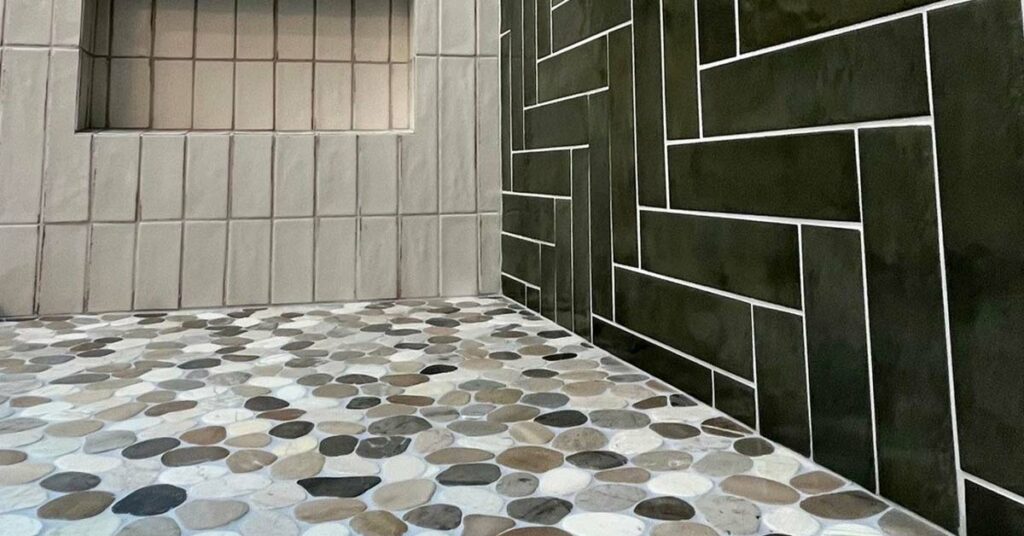
What are the differences between natural stone tile and ceramic tile? These are two of the most widely used types of materials for tile floors and surfaces. In this article we will explore some of their similarities, differences, pros, and cons, so that you can make the best decision about which material to choose for your new tile project.
When you start a new bathroom, kitchen, or floor renovation project, one of the first and most pivotal choices you will need to make is your selection of materials. Although it may be tempting to choose your tile based on eye-candy urges, there are other important factors to consider. For example, your budget may influence your choice of tile. What kind of lifespan are you expecting to get out of your installation? Ease of maintenance and cleanliness matter, too.
Natural Stone Tile
If you are looking for a tile that can outlast your grandchildren, natural stone is a great option. Properly installed stone tiles can endure the test of time, both aesthetically and structurally. The finish of stone can be changed to look pristine and luxurious or more subdued and casual. It can be refinished and restored if the appearance becomes diminished with traffic and use. Natural stone is appropriate for a wide range indoor and outdoor applications.
Sourced straight from the earth and fashioned into tile, natural stone varieties are numerous. As we all know, the surface of this planet has a long history of geological change. Consequently, it would be impossible to describe all the varieties of natural stone here. The types of stone most commonly used for tile include granite, marble, travertine, and slate. Depending on your project, you might also consider using thin brick veneer tiles instead of stacked stone. Although terrazzo is not technically a natural stone, it has many similarities. Let’s take a look at each of these.
Granite Tile
Granite is a gorgeous tile material that comes in a wide variety of colors, with flecks, sparkles, and other visually pleasing features.
Granite can be hefty in more ways than one. It can be expensive, so homeowners with budget limitations may want to steer clear of this material. As a heavy material, it must be properly installed to avoid cracks. The substrate must be properly prepared to handle the weight of the stone.
A very hard material, granite is more resistant to scratching and dulling than other types of natural stone tile. Because of its hardness, granite is more difficult to cut, and this will nudge up the cost of installation. It is an ideal flooring material for high-traffic areas and well worth the investment in the long run.
Marble Tile
For homeowners looking for a luxurious natural stone tile, marble is often the first choice.
Marble can be expensive, depending on where it is sourced. If you plan to sell your home–even decades after marble is installed–you may be pleasantly surprised by the return your investment brings.
Marble can be scratched more easily than granite and can be surprisingly susceptible to surface damage like etching from acidic substances. As such, it is ideal for low-traffic interiors where its beauty can be a focus of the space. Alternatively, you have marble tiles installed in areas that see a lot of use provided you either accept these imperfections or schedule routine services with a stone restoration contractor who can keep it looking great all the time.
Travertine Tile
Travertine has naturally occurring holes, making it ideal for rustic decor. With filled travertine, these holes are filled in with color-matched material, so the finish is smoother and has a more elegant appearance. Color-enhancing sealers can be applied to bring out the striking, rich, and vibrant earth tones of this tile.
An excellent choice of stone for environments with water exposure, travertine is popular for bathrooms, kitchens, and exterior environments.
Travertine can be more cost-friendly than other types of natural stone for your initial purchase. Because of those naturally occurring holes, periodic professional maintenance will be needed to either deep clean the holes in unfilled tiles or replace loose or missing filler in filled tiles.
Slate Tile
Slate is a beautiful option for homes with a modern rustic or minimalist designs. The surface of this type of tile can be slightly uneven and will often feature natural, leather-like contours. Like travertine tiles, slate can be color enhanced with gorgeous results.
Both slate and soapstone were commonly used for chemistry class table tops, according to the Natural Stone Institute. Then, epoxy resin tops came along. Slate is generally resistant to mild acids, making it ideal for environments where exposure to acidic substances is likely, for example, kitchen floors. Slate tiles are also slip and stain resistant.
The cost of slate is generally on the high side, and it can be difficult to install, so plan on spending more for new slate tile in your home. However, it is an exceptionally resilient material.
Stacked Stone vs Thin Brick Veneer Tile
Traditional stacked stone provides a classic, rustic look and is used almost exclusively for vertical applications. This expensive, heavy material is susceptible to stains and difficult to clean. We recommend thin brick veneer tile as a less expensive alternative that is easier to maintain.
Terrazzo Tile
Terrazzo is like a great pair of jeans. It can be dressed up or down, depending on your preference. This material has a mid-century modern flavor and comes in virtually any color to suit your design needs and preferences.
As previously mentioned, terrazzo is not technically a natural stone, but it does contain natural stone aggregates held together in an epoxy or cement base. Like natural stone tiles, terrazzo tiles can be repaired and refinished when signs of wear become apparent.
Terrazzo tile is generally less expensive than natural stone but costs more than ceramic tile.
Natural Stone Tile Pros and Cons
Pros
- Luxurious
- Highly durable
- Can be refinished to like-new condition
- High return on investment
- Wide variety of colors, veining, textures, and finishes
Cons
- Needs periodic professional cleaning, sealing, repair, and restoration
- More susceptible to moisture damage and staining (if it is porous and not sealed) than ceramic tile
- Some types are susceptible to etch damage from acidic substances
- More expensive than ceramic tile
- Weight may require additional substrate prep
- Some types of stone are more difficult (expensive) to install
Ceramic Tile
If you are looking for a budget-friendly alternative to natural stone, ceramic tile is a great option. Although there is nothing quite like the appearance and longevity of natural stone tile, ceramic tile can provide a similar aesthetic experience and last for decades with proper installation.
If the appearance of ceramic tile becomes diminished after years of traffic and use, a tile restoration contractor can often repair and restore it to dramatically improve its appearance. Ceramic tile is appropriate for a wide variety of interior applications. For exterior applications, we recommend porcelain tile (which is a type of ceramic tile).
As a manufactured material, ceramic tile design varieties are virtually limitless. The main functional difference between types of ceramic tiles are their hardness and how resistant they are to liquid absorption, which is a result of how porous they are. It should be noted that lower quality ceramic tile tends to be less durable than natural stone, but it is also less absorbent, making regular cleaning and care easier. Let’s look at a few types of ceramic tile.
Glazed Ceramic Tile
This type of tile comes manufactured with a glass-like, glossy finish that resists stains.
Porcelain Tile
The strongest and most durable of ceramic tiles, porcelain tile is kiln fired and pressed at higher temperatures and pressures than standard ceramics, using denser and finer clay. Porcelain a higher quality ceramic tile that can be glazed or unglazed.
Quarry Tile
Made from natural shale and clay, quarry tile are unglazed with earthy tones. This durable type of tile is popular for very high-traffic environments.
Terracotta Tile
Terracotta is a quarried material. Manufacturers use natural clay to make glazed or unglazed terracotta tiles. This material has a Mediterranean look that is suitable for both inside and outside.
Ceramic Tile Pros and Cons
Pros
- Low porosity (water resistant)
- Generally less expensive and easier to install than natural stone tile
- Relatively easy to maintain and ideal for pets
- Wide variety of colors and styles and can mimic the appearance of other surfaces
- Useful in almost every living space where tile can go
Cons
- Porcelain can be expensive
- Generally less longevity than natural stone
- Lower return on investment than natural stone
- Signs of wear may be more noticeable and more difficult to repair and restore than natural stone
NOTE: Both natural stone tiles and ceramic tiles are good conductors of heat, allowing for radiant heating technology.
Whether your project is a bathroom renovation, a kitchen makeover, or a new construction installation, material selection is a critical decision that cannot be undone once your tile is set. While the visual allure of certain types of tile may be strong, the decision-making process should go deeper than the surface. Consider each of the factors in this article before choosing the perfect tile for your project. Feel free to reach out to us with specific questions or concerns regarding your tile material selection.
by Alice Dean
Copher Tile & Stone proudly stays up to date on tile floor installation with ongoing education with Mapei Technical Institute, Ardex Academy, the National Tile Contractors Association, Laticrete, and Schluter. Copher is a Certified Tile Installer (#1644).

